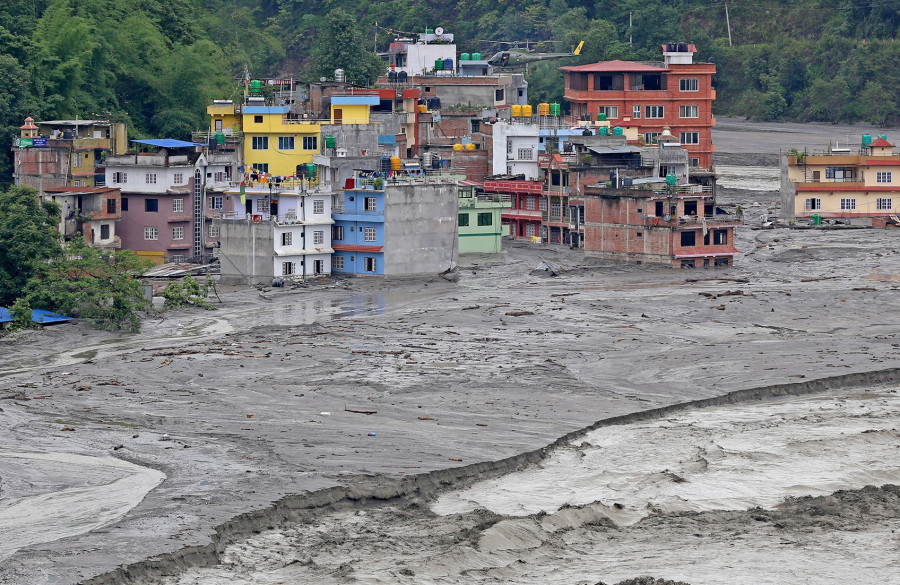Columns
Disjointed climate planning
Building roads haphazardly in the hills has led to erosion and landslides during the monsoon.
Madhukar Upadhya
It’s been more than a decade since Nepal formulated its first climate change policy, prioritising the issue because of its potentially damaging impacts on multiple facets of our prosperity. Strategies and plans have been developed to implement the policy but the very same people who are believed to be the most impacted, and many of whom—though opinions may differ—have actually been impacted already, aren’t able to connect or trace their grievances back to climate change, much less how it will affect them in the future. It’s either because their priorities are different from what we think they should be or they aren’t as severely affected by climate impacts as we think they are.
The goals and approaches set in the policies and strategies don’t appear as strongly and with the required urgency in the annual government plans nor are they discussed in Parliament or the Provincial Assemblies while approving the said government plans. So much so that even the plans of the local governments hardly reflect them. Rather our annual development plans remain laden with conventional projects for roads, water supplies, irrigation and so on. This mismatch raises questions as to why climate issues are not yet the subject of the people and their political representatives. What is causing this disconnect?
The disconnect
There may be several reasons for this schism, but some stand out. The first, and perhaps most important, is how we communicate the issue publicly. As put forth by Elaine Kamarck, a political scholar and a public policy expert, the three categories of complexity, jurisdiction and communication help explain this incongruity. Unlike the environmental problems of the 1970s and 1980s, where cause and effect were often clear because of their limited jurisdiction, usually confined to a local area, the complexities of climate change with its global jurisdiction and an array of teleconnections make it nearly abstract for many to comprehend. Communicating the seriousness of the issue with the public, thus, becomes a challenge.
Additionally, it hasn’t become an issue in our political conversations either for this very reason! The climate discussion generally revolves around the newly-minted axiom that climate change is a global problem and requires global solutions. That is true for mitigation. But adaptation—which is equally if not more crucial for us—is a local issue, and that is where local leaders and communities should be taking the lead. Unfortunately, that isn’t happening because we’re unable to effectively communicate the real problem we’re facing.
Second, the contribution of agriculture to the national GDP has been falling rapidly, substituted largely by the service sector and remittance. The income from the labour market has helped rural communities to thrive, allowing them to move away from farming. Off-farm employment has blurred the lines between the rural and urban economies. Declining or loss of crop production, often as a climate consequence, is less of a concern for the rural population in the same manner as it has always been for the urban population. Consequently, climate impacts on agriculture don’t get as much attention as other sectors with corporate interests.
The third is our development model which isn’t quite compatible with climate change. Even a decade after the issuance of the policy, rather than addressing the climate issues surrounding agriculture, our pursued development model remains dominated by investments in infrastructure which have often been proven to multiply climate risks that communities already face. Building roads haphazardly in the hills is a glaring example that has led to increased erosion and landslides during the monsoon. Building view towers on mountain tops to promote tourism is another example of communities not being aided in adaptation efforts against climate impacts. Most of these highly placed infrastructures don’t actually address the needs of the agriculture-dependent communities whose very existence is tied to sustainable farm productivity.
The tragic events we witnessed in the Indian states of Himachal Pradesh and Uttarakhand should serve as a forewarning regarding the future of the infrastructure-laden development model in the mountains. At least three overlapping factors seem to be responsible for these devastating events: The continuation of an unchanged and often inapt model of development on the poorly understood diverse geological setting of the Himalaya; an illimitable hunger for economic activity altering the landscape and local hydrology of the mountains; and the rapidly becoming increasingly unpredictable monsoon rain. In Nepal, we have continued with similar models of development on the same mountain range to promote more economic activity such as faster connectivity, power generation, tourism and so on. The same communication challenges make it difficult to relay the complexities of climate threats we face and the seriousness of this overlap to our planners as well.
Intricate interplay
The fourth is about our ability to understand the dynamics of the interplay between the growing randomness of the weather patterns and the young and rising mountains exploited in every possible way for economic gain. Contrary to what we may believe, the integrity of the natural environment around us isn’t as stable as we think. With the increased uncertainties of erratic rainfall and other extreme events, more surprises are in store for us. Floods in the eastern parts of the country in 2023 were as unexpected as the Melamchi floods of 2021, the floods in the Tarai in 2017 or the drought of 2009.
A common refrain as to how we should prepare for future disasters is usually: More studies and research to understand what is happening and prepare better for such events. But we must recognise that the natural hydro-meteorological picture in the 21st century is becoming increasingly wobbly. These changes are taking place faster than we can build models or conduct studies to better understand ways to address the problem. It’ll be years, if not decades, before a trend can be established, if the hydro-meteorological phenomenon develops any trend at all. Even if we carry out studies following every major event to understand the underlying causes and formulate ways to mitigate then, the ground reality will change drastically with each subsequent event, demanding further studies to understand the new context.
Therefore, it’s high time that we recognised the limitations of the mountains and our quest for economic growth using the development model that has gotten us to the state of environmental chaos we’ve been facing in recent years. Similarly, we need to find ways to communicate to both the planners and the communities the complexities entailed in the changing climate and their real world impacts as well as ways to adapt. And, the biggest challenge is to develop our technical capacity to understand the growing menace as soon as the scenario changes, which, unfortunately, is a tall order with no real alternative.




 12.99°C Kathmandu
12.99°C Kathmandu













%20(1).jpg&w=300&height=200)

